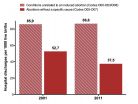(Press-News.org) This news release is available in German.
Microbiologists and molecular biologists at ETH Zurich and the University of Bonn have discovered a new agent in fungi that kills bacteria. The substance, known as copsin, has the same effect as traditional antibiotics, but belongs to a different class of biochemical substances. Copsin is a protein, whereas traditional antibiotics are often non-protein organic compounds.
The researchers led by Markus Aebi, Professor of Mycology, discovered the substance in the common inky cap mushroom Coprinopsis cinerea that grows on horse dung. When they began their research, the scientists were interested in understanding how this fungus and various bacteria affect each other's growth. This involved cultivating the fungus in a laboratory along with several different types of bacteria. It was found that C. cinerea is able to kill certain bacteria. Further research demonstrated that the copsin produced by the mushroom is responsible for this antibiotic effect.
Copsin belongs to the group of defensins, a class of small proteins produced by many organisms to combat microorganisms that cause disease. The human body also produces defensins to protect itself against infections. They have been found, for example, on the skin and in the mucous membranes.
A question for basic research
For Aebi, the main focus of this research project was not primarily on applications for the new substance. "Whether copsin will one day be used as an antibiotic in medicine remains to be seen. This is by no means certain, but it cannot be ruled out either," he says.
The ETH professor is much more intrigued by fundamental questions, such as how fungi have used defensins and other naturally antibiotic substances for millions of years to protect themselves against bacteria. Why does this work for fungi while humans have been using antibiotics in medicine for just 70 years with many of them already becoming useless due to resistance? "Fungi have internal instructions on how to use these substances without resulting in selection of resistant bacteria. How to decode these instructions is an intriguing problem for basic research," explains Aebi.
An extremely stable protein
Andreas Essig, a postdoc in Aebi's group and lead author of the study, is currently exploring potential applications for copsin that has been registered for patent approval. It was the biochemical properties of the substance that led the scientist to do so. "Copsin is an exceptionally stable protein," says Essig. Proteins are generally susceptible to protein-degrading enzymes and high temperatures. Copsin is an exception because it also remains stable when heated to a temperature of 100 degrees Celsius for several hours or when subjected to protein-degrading enzymes. The researchers believe that the protein has these properties because of its extremely compact three-dimensional structure, as NMR spectroscopy has shown.
The ETH researchers were also able to unravel the exact mechanism of action, discovering that copsin can bind to lipid II, an essential building block for the cell wall of bacteria. "Building the cell wall is the Achilles heel of bacteria," explains Essig. If copsin binds to lipid II, the bacteria die because they are unable to build new cell wall.
In addition to being used as an antibiotic in medicine, it may also be possible to use copsin in the food industry as well. This is because copsin kills many pathogens including Listeria, a type of bacteria that can cause severe food poisoning and is therefore feared, especially in the production of non-heat treated foodstuffs such as raw milk cheeses and dried meats.
INFORMATION:
Literature reference
Essig A, Hofmann D, Münch D, Gayathri S, Künzler M, Kallio PT, Sahl HG, Wider G, Schneider T, Aebi M: Copsin, a novel peptide-based fungal antibiotic interfering with the peptidoglycan synthesis. Journal of Biological Chemistry, online publication 23 October 2014, doi: 10.1074/jbc.M114.599878 [http://dx.doi.org/10.1074/jbc.M114.599878]
An international research project, which includes researchers from the U. of Granada, has proved the need for campaigns to persuade parents of the benefits involved in having their children walk to school. This also includes work on the perception about the security of the paths their children need to follo won the way to school. This research points out, besides, the need for public administrations to actively campaign to persuade children and their families to walk more often as part of their daily routines.
Many different surveys have demonstrated that walking to school ...
Since suitable studies are lacking, it remains unclear in which sperm analysis parameters assisted reproduction using intracytoplasmic sperm injection (ICSI) can be superior to in vitro fertilization (IVF). This is the conclusion of the final report published by the Institute for Quality and Efficiency in Health Care (IQWiG) on 6 November 2014.
Benefit assessment depending on parameters
The Federal Joint Committee (G-BA) commissioned IQWiG with the examination of two research questions: First, the researchers were to assess the benefit of ICSI in comparison with IVF ...
Eribulin (trade name: Halaven) is approved for women with locally advanced or metastatic breast cancer in whom the disease has progressed despite prior drug therapy. The German Institute for Quality and Efficiency in Health Care (IQWiG) examined in a dossier assessment whether the drug offers an added benefit over the appropriate comparator therapy in these patient groups.
According to the findings, there are both positive and negative effects. There is proof of minor added benefit for one group of patients. For other groups, there are hints or indications of lesser ...
The current classification system for colorectal cancer, which is based on genetic expression profiles, cannot be used to predict drug responses to FOLFIRI. This is the conclusion reached by a team from the Spanish National Cancer Research Centre (CNIO), formed by members from the Gastrointestinal Cancer Clinical Research Unit and the Structural Computational Biology Group. The study, published this week in the journal Nature Medicine, will assist oncologists in making better-informed decisions regarding how to treat their colorectal cancer patients in the clinic.
Conclusions ...
Published in Nature Biotechnology, the study showed that specially engineered lipid (fat) bodies, called liposomes, can be used to prevent bacterial toxins from killing human cells.
This could prevent unnecessary deaths from diseases such as pneumonia and sepsis. The treatment is a valuable alternative to current medications, particularly for infections that have become resistant to antibiotics.
The bacterial toxins, produced by major human pathogens such as Streptococcus pneumonia, Streptococcus pyogenes and Methicillin Resistant Staphlycoccus aureus (MRSA) were ...
During hibernation, dormice enter into 'torpor' to save energy and water. In this state, the dormice become inactive and show a marked decrease in their metabolic rate, causing their body temperature to reduce.
Torpor was then found to be a strategy used when food availability was limited. The researchers compared two groups of juveniles born late in the season - one able to feed freely and the other intermittently fasted on alternate days. The fasted dormice showed considerably greater use of torpor, enabling them to maintain high growth rates and accumulate sufficient ...
Muscle-specific protein cofilin-2 controls the length of actin filaments in muscle cells.
Sliding of myosin and actin filaments past each other provides the force for muscle contraction. In contrast to most non-muscle cells, the actin filaments in muscle sarcomeres are of precise length and relatively stable. Defects in the organization of these actin filament arrays result in various heart and muscle disorders, such as myopathies.
The research group of professor Pekka Lappalainen at Institute of Biotechnology, University of Helsinki, has now revealed a new mechanism ...
Bethesda, MD -- After many generations, rats bred for their bad attitude behave differently from those selected for a calm demeanor around humans. Research published November 7 in the journal GENETICS identifies gene regions that contribute to differences between nasty and nice rats in their behavior and the activity of genes in the brain. These results may provide important clues as to which genes make tame animals like dogs behave so differently from their wild ancestors.
"Tameness is one trait that all domestic animals share. Whether it's pigs or cats or horses, domestication ...
This news release is available in Spanish.
Legal restriction of abortion has a negative connotation since the idea of women resorting to illegal abortion -risking their own lives- is strongly rooted in the public opinion worldwide. However, a series of independently peer-reviewed articles, challenge this notion in some countries. The latest data in this subject have been discussed by the Chilean epidemiologist Elard Koch, Director of Research of the MELISA Institute, in the current issue of the official journal of the Chilean Society of Obstetrics and Gynecology. ...
SALT LAKE CITY, Utah, Nov. 7, 2014 - Myriad Genetics, Inc. (Nasdaq: MYGN) today presented results from a prospective clinical utility study of its Myriad myPath Melanoma test at the 2014 American Society of Dermatopathology (ASDP) annual meeting in Chicago, Ill. Myriad myPath Melanoma is a genetic test that differentiates malignant melanoma from benign skin lesions across all major melanoma subtypes. Key findings of this clinical utility study included a 43 percent reduction in indeterminate diagnoses and a 49 percent change in physicians' treatment recommendations for ...


